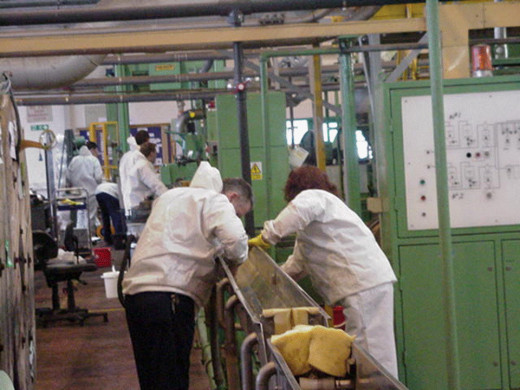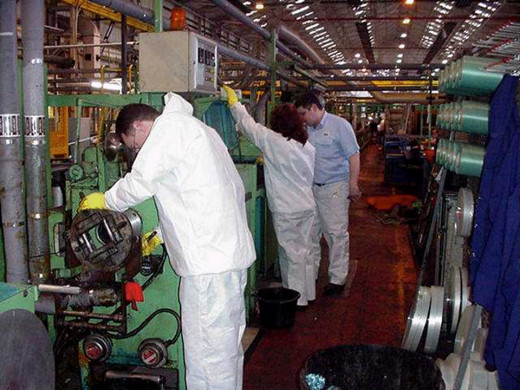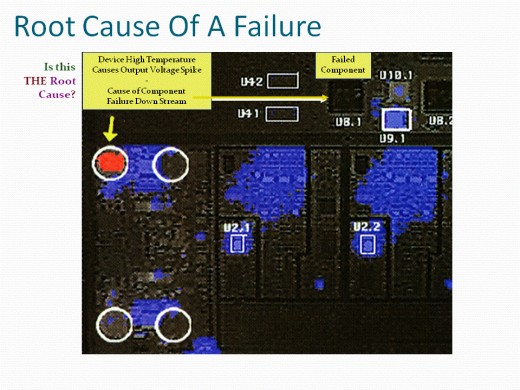Predictive Maintenance; Definition, Services, Methods and Technologies
What is Predictive Maintenance
This Article will look at predictive maintenance, it will define what predictive maintenance is, how it differs from other approaches and the different techniques, methods and technologies that can be used such as infrared thermal Imaging, vibration analysis and oil analysis, NDT crack detection and many others.
Maintenance of equipment and machines seeks to prevent often expensive and disruptive breakdowns by replacing or refurbishing components prior to them actually failing. Predictive maintenance is a technique that allows you to see if your equipment requires maintenance work by looking at the actual condition of the equipment rather than looking at past history or making a "guess" as to when things need to be replaced.
Maintain production equipment


Implementing Predictive Maintenance
Predictive Maintenance vs Preventive Maintenance
In any productive maintenance program we want to maximise the life and efficiencies of our assets in the most economical way possible. Traditional methods use time or cycle based counts to define when maintenance is required much like you would for your car, so we would replace the oil every 6000 miles and the timing belt every 50,000 whether it was actually required or not. This is preventative or preventive maintenance and is more economical for us than running until a failure occurs. These failures occurring without warning and at usually huge cost. Compare the cost of repairing your car engine after your timing belt breaks against the regular timely replacement.
Predictive maintenance however uses performance data and various non destructive testing techniques to ascertain the actual condition of the machine allowing us to accurately predict when a failure is going to occur and extend the periods between our just in case preventative maintenance routines making them more cost effective. For instance using our car servicing analogy; a simple test of the cars oil could tell us if the oil had degraded to a point where it was less effective and needed replacement (many modern engines and lubricants could easily last twice as long or more as the manufacturers recommend between changes.) The analysis could also tell if the oil was carrying particles caused by wear within the engine. The particle size and composition could tell us exactly where the wear was coming from and how advanced it was allowing us to plan to take action before we had a catastrophic failure.
So whilst there are obvious benefits to using predictive methods over preventive maintenance there is a cost associated with the predictive methods which should be considered, if the costs of implementation are likely to be greater than the savings you will make over the simpler preventive maintenance system then it would be better to remain with that system, a discussion regarding predictive vs preventive maintenance can be found by clicking the link.
Predictive Maintenance Methods

Predictive Maintenance Technologies
The following sections will give you a brief overview of some of the predictive maintenance technologies and techniques that can be utilized within your operations to predict when you will need to perform remedial works on your machines and equipment.
Thermal Imaging Video
Infrared Thermal Imaging
You have all seen the TV shows with the police chasing the criminals at night using their heat sensing cameras and the army sniper picking out the heat source of the enemy even under his hiding place, well this is exactly what this technique does in your workplace. It looks for the hotspots caused by excess friction, overloading circuits and other heat generating problems and highlights them as the enemy to be taken out!
This technique does not interfere with your daily production and can quickly highlight problems especially if you have an “as new” reading to compare against. This technique is a very simple one to utilise and can find not only mechanical problems but also electrical issues and also leaks.
Infrared thermal imaging also has a more far reaching application than just looking at your individual machines and processes, it can also be used to identify areas of your plant where heat is escaping or even where water leaks are forming in your roof enabling you to take action.
Vibration Analysis Video
Vibration Analysis
Vibration analysis can monitor a machines vibration patterns and identify the existence of wear and issues such as failing bearings by comparing patterns over time and against known failures. This is an easy to use analysis method once you have been trained and understand what it is you are looking for.
Vibration Analysis monitors can either be hand held devices or can be built directly into the machines enabling feedback to a central system or even to an external company who will analyse and provide you feedback.
Sonic and Ultrasonic testing
These techniques can identify failures in much the same way as vibration analysis but can be more sensitive and be effective over a wider range of machines and failure modes. All machines make noise even if the noises are sometimes beyond the ranges of normal hearing, even electrical circuits.
It can also detect cracks and other defects within your machinery that may not be visible to the naked eye such as poor weld conditions that could fail.
Once again significant training is required to be able to interpret the results and be able to compare them against normal readings.
Oil Analysis
Oil analysis is a predictive maintenance method that looks at both the effectiveness of the oil itself to prolong its use and not keep replacing it before it has reached the end of its life and at the actual wear of the machine itself by analysing the particles within the oil.
The size and makeup of the particles within the oil can indicate the level and whereabouts of wear occurring within the machine enabling you to know what is wearing and by how much. This can technique can be a very accurate and highly sensitive method to use to prolong the life of your machinery.
NDT Crack Detection
In addition to ultrasonic analysis there other non destructive testing (NDT) methods that can be employed to check for cracks in the metal structure of your machinery, unlike some of the other tests above however the machine will have to be stopped and sometimes the components stripped out to be checked.
The use of liquid penetrant dies that highlight hairline cracks is one method that has been used for many decades and is an easy and inexpensive way to discover if critical pieces of metal have become fatigued and cracked.
Emission Testing
There are monitors available to measure the makeup of gasses and even effluent from your machines and equipment which can also give you warning as to possible deterioration in your machines enabling you to take action before an actual breakdown occurs.
Predictive Maintenance Software
Condition Monitoring
Condition Monitoring can utilise a combination of sensors that use many of the techniques suggested above plus monitor other attributes of the machine. These sensors built into the machines enable a full picture of how the machine is operated to be seen, with things like torques being measured and currents being drawn you can start to see when things are starting to move beyond normal operating conditions indicating the need for investigation or replacement.
These condition monitoring sensors can either be part of an individual machine, a company system or be monitored via an external company that will provide you with support.
Outsourcing Predictive Maintenance
In may cases it can be more economical to outsource your predictive maintenance needs, an external company will employ people who are already trained and experienced in the various testing methods and may also be less inclined to err on the side of caution as some internal practitioners are prone to do.
An external company should also have access to the various tools and equipment that is required to be able to undertake the required analysis allowing you to avoid the expense of investing in all of the tools and training.
TPM Video
Predictive Maintenance and Total Productive Maintenance (TPM)
Total Productive Maintenance or TPM is part of Lean Manufacturing and seeks to ensure that everyone in the company is involved in ensuring that machines and equipment are reliably and efficiently maintained in the most economical ways possible whilst focusing on ensuring that the final customer is best served.
Predictive maintenance and preventive maintenance are both significant parts of any TPM program and should be implemented along with autonomous maintenance which involves the operators that use the machines in performing basic maintenance tasks. TPM also introduces us to ideas such as SMED or Single Minute Exchange of Die to reduce losses due to slow setups and also to Poka Yoke to prevent the creation of defects.
Whether you instigate Predictive maintenance as part of an overall TPM program or as a standalone maintenance system I hope this has given you some ideas.









